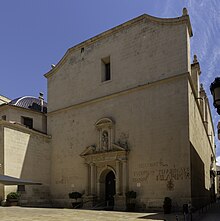Concatedral de San Nicolás, Alicante
| Alicante Co-Cathedral | |
|---|---|
| Co-Cathedral of Saint Nicholas of Bari | |
| |
 West façade in 2021. | |
 | |
| 38°20′43.5″N 0°28′57″W / 38.345417°N 0.48250°W | |
| Location | Alicante |
| Address | 2, Plaza del Abad Penalva |
| Country | Spain |
| Denomination | Catholic |
| Website | concatedralalicante |
| History | |
| Authorising papal bull | 9 March 1959[1] |
| Status | Cathedral |
| Dedication | Saint Nicholas |
| Architecture | |
| Architect(s) | Agustín Bernardino |
| Style | Valencian Gothic, Baroque |
| Groundbreaking | c. 1613 |
| Completed | c. 1660 |
| Specifications | |
| Dome height (outer) | 45 metres (147 ft 8 in) |
| Administration | |
| Metropolis | Valencia |
| Diocese | Orihuela-Alicante (since 1959) |
| Clergy | |
| Bishop(s) | José Ignacio Munilla Aguirre |
| Type | Non-movable |
| Criteria | Monument |
| Designated | 15 June 1974 |
| Reference no. | RI-51-0003945 |
The Co-cathedral of Saint Nicholas of Bari (Valencian: Cocatedral de Sant Nicolau de Bari, Spanish: Concatedral de San Nicolás de Bari) is a Roman Catholic co-cathedral located in Alacant, in the Valencian Community of Spain. The church, part of the Diocese of Orihuela-Alicante is dedicated to Saint Nicholas and was elevated to the title of cathedral on 9 March 1959 by Pope John XXIII.
Design[edit]

This church was built between 1613 and 1662. It was designed between 1610 and 1615 by Agustín Bernardino, a student of Juan de Herrera,[2] and was constructed over an ancient mosque. The older cloister was built originally in the 15th century in Valencian Gothic style.
The cathedral has a Latin cross plan, though the transepts are quite short. Flanking the nave are six interconnecting side chapels and an ambulatory around the apse. A blue dome rises 45 meters above the crossing. The chapel of Holy Communion, configured as a small Greek cross-planned temple, is considered to be one of the most beautiful examples of the Spanish Baroque.[2]
The external appearance of the cathedral is quite sober. The main facade located on the east side is of the Doric order, and the one built on the south side is of Ionic order.[2]
References[edit]
- ^ "Historia y Arte". Concatedral de Alicante. Retrieved 2024-03-29.
- ^ a b c Concatedral de Alicante Diócesis de Orihuela-Alicante. (in Spanish) Archived April 17, 2009, at the Wayback Machine
External links[edit]
- Official website of the San Nicolas Cathedral (in Spanish)
- Buildings and structures in Alicante
- Roman Catholic cathedrals in the Valencian Community
- 17th-century Roman Catholic church buildings in Spain
- Roman Catholic churches completed in 1662
- Baroque architecture in the Valencian Community
- Herrerian architecture
- 1662 establishments in Spain
- Bien de Interés Cultural landmarks in the Province of Alicante
- Religion in Alicante

